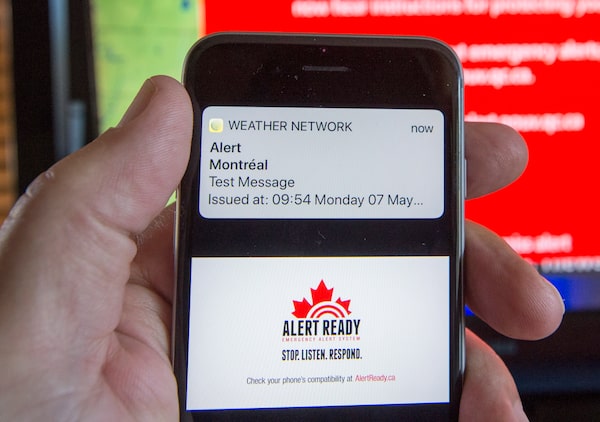
Alert Ready allows government officials to issue public safety alerts through major television and radio broadcasters, as well as compatible wireless devices.Ryan Remiorz/The Canadian Press
British Columbia is joining Canada’s direct-to-cellphone alerting system for floods and wildfires, but the tool won’t be used for extreme heat events like the one that killed more than 500 people in the province last summer.
Alert Ready was rolled out four years ago across Canada, but British Columbia is the last province to embrace the system, which allows government officials to issue public safety alerts through major television and radio broadcasters, as well as compatible wireless devices.
B.C. had agreed to use Alert Ready for tsunamis, amber alerts for abducted children, and civil disturbances.
But despite years of planning, it did not have the system in place for the natural disasters that hit the province in 2021, a calamitous year of floods, debris slides, wildfires, and the deadly heat dome.
On Tuesday, Public Safety Minister Mike Farnworth said the province is rushing to expand the system now for floods and wildfires, as forecasters warn of an elevated risk this year on both fronts. There are already troubling signs of drought in the Interior, and a higher-than-normal snowpack that increases the chances of flooding in some communities when the snow melts.
“In many ways, British Columbia is on the front lines of climate change in Canada,” Mr. Farnworth said at a news conference. “From wildfires and extreme heat to flooding, storms and mudslides, we’re finding our province at risk like never before. … And it’s clear that we all need to do more to keep our communities safe.”
But he said there is still work to be done before the province would consider warning residents of a dangerous heat wave, such as determining what temperatures would trigger an alert. Temperature records were smashed in 62 locations in Western Canada last summer. According to the BC Coroners Service, the province had 595 heat-related deaths in 2021, mostly during the heat dome that lasted from June 25 to July 1.
Vancouver mayor wants new renter-protection policy
By contrast, two people died when a wildfire consumed the town of Lytton last summer, and at least five people died when unprecedented rainstorms in November led to widespread flooding and debris slides.
The B.C. government has said it expects the province to experience more frequent and more severe weather events because of climate change. The June heat wave was the most deadly weather event in Canadian history, according to the B.C. Centre for Disease Control, and it overwhelmed the province’s emergency medical systems.
Some communities, tired of waiting for the province to adopt emergency warning systems, have implemented their own.
The village of Ashcroft in B.C.’s Interior hosted a pilot project in 2018 to see how small communities can help residents in extreme heat. The community then paid for its own alert system, which was used for the heat dome in 2021, when Ashcroft experienced one of the province’s highest-ever recorded temperatures, a record-breaking 48.1 C on June 29.
Ashcroft Mayor Barbara Roden said the alert system was a success, and it was used again in mid-July when the community was threatened by wildfire.
“With all the disasters we’ve had, whether it’s fires or floods, communication is just such a huge, huge thing. Which is why so many people were scratching their heads at why the province did not put out a provincewide alarm during the heat dome,” she said in an interview.
The village opted into a private system “partly because we didn’t see that lead from the province in terms of emergency notifications,” she said. “If they can push out a tsunami warning to Ashcroft – and if we have to worry about a tsunami in Ashcroft, then, boy, are we in trouble – why can they not push out a heat dome warning to Ashcroft?”
A recent report on the pilot project, published in the Canadian Journal of Public Health, found positive outcomes. “The result is a sustainable public health intervention that has the potential to mitigate the negative health effects of extreme heat,” the study found.
The study noted that heat waves have been linked to excess mortality, particularly among infants, older adults, people working outside and those with poor access to stable housing. “Fortunately, heat-related illness is entirely preventable through individual, community, and policy interventions.”
The report offers one clue to the province’s caution about sending out emergency warnings, citing a 2019 B.C. government report on wildfires. “It was recommended that the word ‘alert’ should be avoided, as it was flagged as a potential trigger in creating anxiety within the community due to recent threats from wildfires.”
Mr. Farnworth echoed that concern on Tuesday, saying the province’s alert system will have to be used carefully. “You don’t want something going too widespread that alarms people unnecessarily. So we’ve been working very closely with local governments, and I’m sure that we will learn from the lessons of implementation, but it is going to be a big improvement.”
We have a weekly Western Canada newsletter written by our B.C. and Alberta bureau chiefs, providing a comprehensive package of the news you need to know about the region and its place in the issues facing Canada. Sign up today.
 Justine Hunter
Justine Hunter